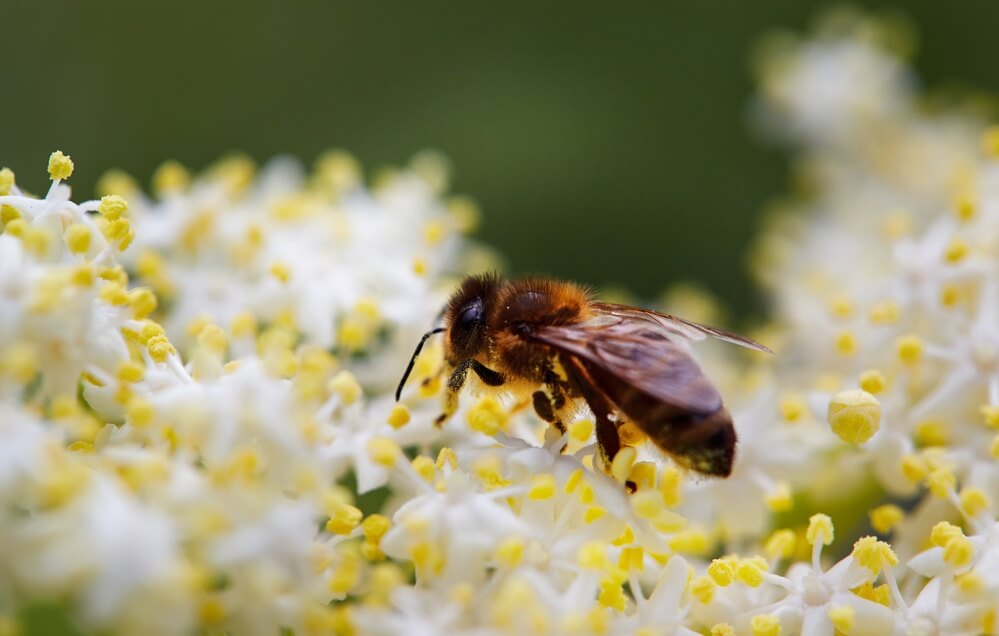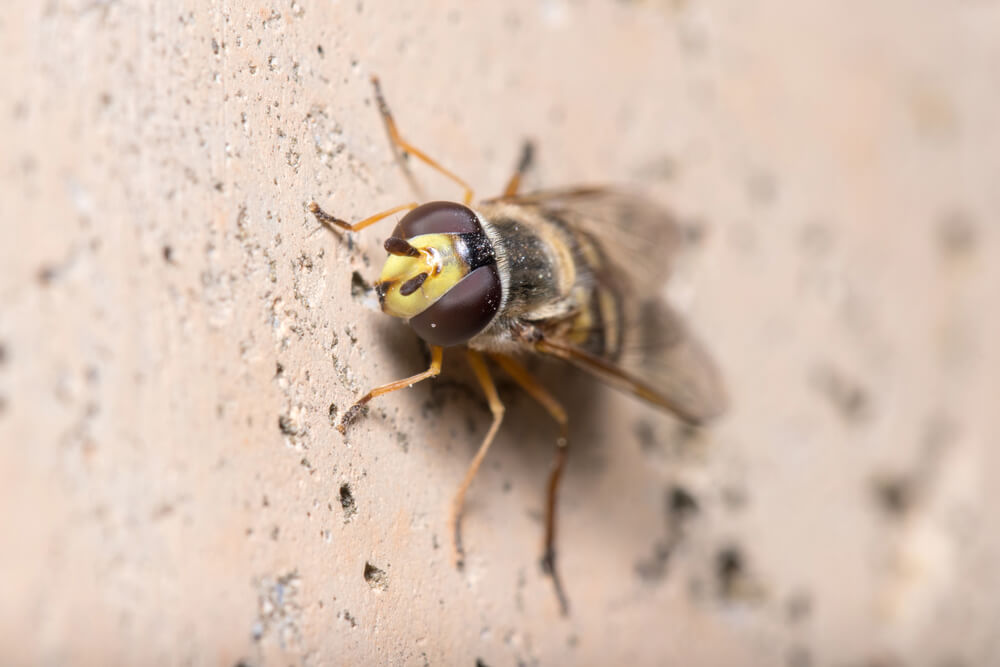Table of Contents:
What Are Black Honeybees?
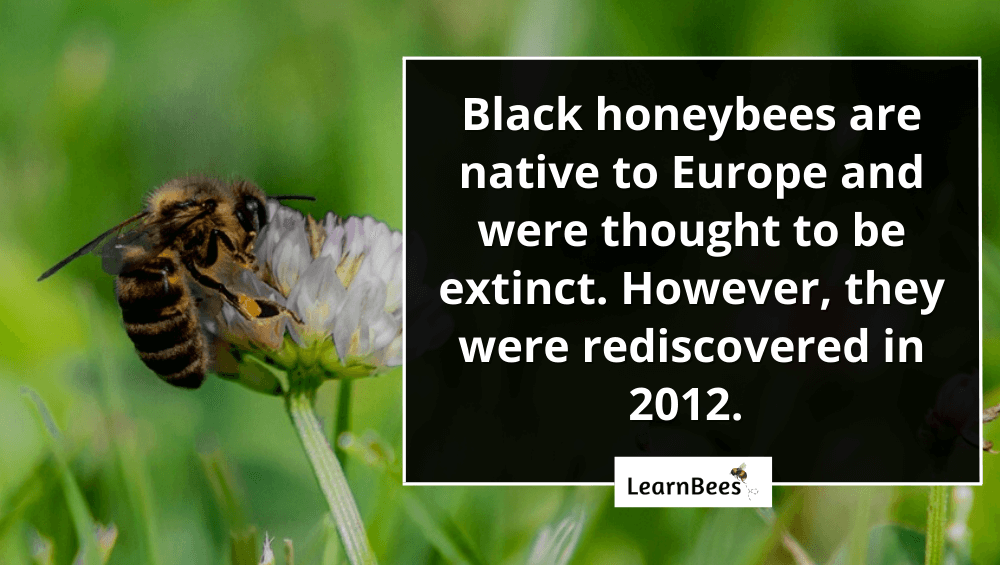
The European black bee (Apis mellifera mellifera) is a type of honeybee that was previously thought to be extinct.
These black honeybees are native to Europe and are sometimes referred to as “German black bees” or “European dark bees.”
And the good news?
These black honeybees aren’t extinct. They were discovered again in 2012 in north Wales, east Anglia, and west Sussex.
Interestingly enough:
Researchers believe that black honeybees are hardy bees that are better adapted to survive harsh European winters. Since they’re native to Europe, they’re more accustomed to the local climate.
With that said:
European black bees are known for having higher levels of aggression, an increased tendency to swarm, and a higher susceptibility to pests and diseases.
And as their name suggests:
Black honeybees tend to be darker in color than other types of honeybees. However, this doesn’t mean that they’re entirely black. Instead, they’re partially brown-black with a few light yellow spots on their abdomen.
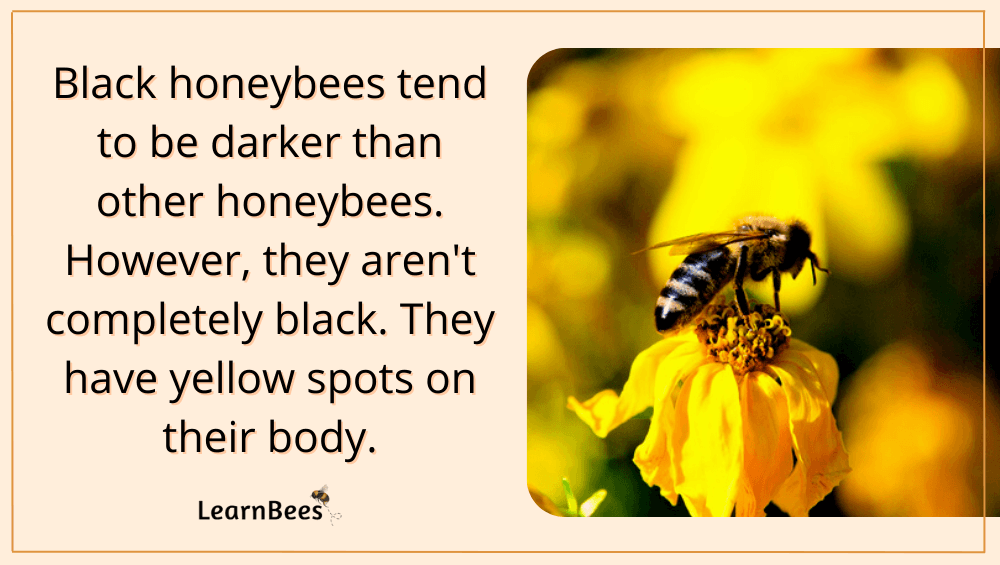
They may also have slightly larger bodies with longer, thicker hair. The extra hair allows them to keep warm in the cold European climates they originate from.
That said, black honeybees shouldn’t be confused with Carniolan honeybees (Apis mellifera carnica) or other bee species.
Many people in the United States believe they’ve stumbled upon black honeybees. However, no evidence suggests that black honeybees currently live in North America.
As far as we know, black honeybees are currently only found in Europe.
More importantly?
Black honeybees can’t be legally imported into the United States. The Honey Bee Restriction Act of 1922 bans the importation of honeybees into the United States.
While the law has been revised multiple times and has a few exceptions, it still doesn’t allow honeybees to be brought in from Europe.
Do Black Honeybees Sting?
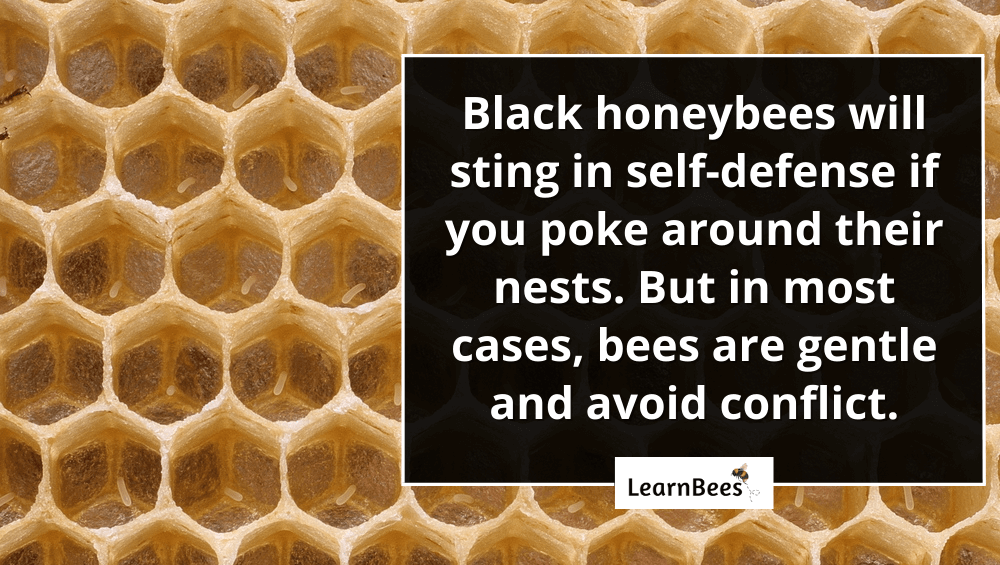
Black honeybees can sting if threatened.
But keep in mind:
Only female black honeybees can sting. Male black honeybees cannot. A bee’s stinger is a modified egg-laying organ, so only female bees have them.
With that in mind, European black honeybees are known to be more defensive than other honeybees.
To quote Karl Kehrle, who was the only beekeeper with hands-on experience with black honeybees:
“The native (Old British Black) bee had undoubtedly many extremely valuable characteristics, but equally so a great many serious defects and drawbacks. She was very bad-tempered and susceptible to brood diseases and would, in any case, not have been able to produce the crops (of honey) we have secured since her demise.”
What’s more:
One study of 621 bee colonies found the European black honeybee (Apis mellifera mellifera) to be the most aggressive, with the highest tendency to swarm.(1)
Additionally, the European black honeybees were observed as having the lowest hygienic behavior. In turn, this can lead to varroa mites and other pests.
Do Black Honeybees Make Honey?
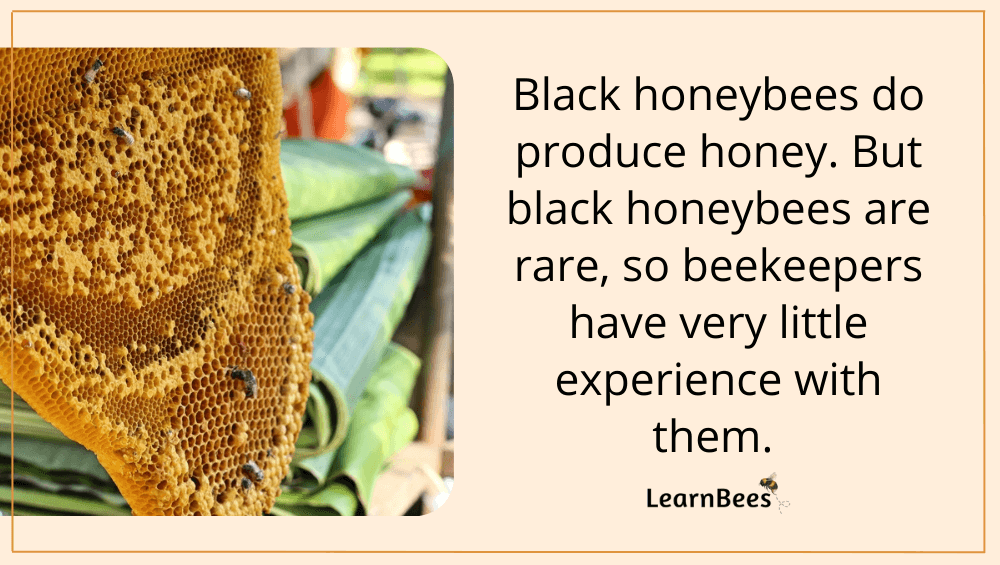
Like other types of honeybees, the European black bee also produces honey.
There are more than 300 varieties of honey. For instance, heather honey comes from honeybees pollinating the heather plant (Calluna vulgaris).
The heather plant is native to Europe and allows the bees to create a mildly sweet honey with smoky undertones.
That said, black honeybees are rare and have only been rediscovered in Europe thus far. We don’t have much first-hand knowledge or experience showing how much honey these bees can produce.
For example, one study showed that African honeybees produced less honey than European honeybees.(2)
Also, honey from the European black honeybee isn’t widely harvested and sold. The “typical” European honeybees (Apis mellifera) are what drive the honey industry around the globe.
FAQs on Black Honeybees
- What is a black honey bee?
- What causes black honey bees?
- Is a black bee rare?
- Are black bees harmful?
- Why do I keep finding black bees in my house?
- What are black bees good for?
- Where do black bees live?
- Do black bees bite?
- What are black bees attracted to?
- Why do black bees follow me?
- How do you get rid of black honey bees?
- Are all black bees carpenter bees?
What is a black honey bee?
Black honeybees are a type of bee that’s native to Europe. It was thought to be previously extinct until 2012, when it was rediscovered in north Wales, east Anglia, and west Sussex.
The black honeybee goes by many names, including:
- German black bees
- European dark bees
- German dark bees
From a distance, the European black honeybees may appear completely black, dark gray, or dark brown. However, they have a few light yellow spots on their abdomen, so they aren’t entirely black, as their name suggests.
But as a general rule, European black bees tend to be darker than other types of honeybees. They also tend to have slightly larger bodies covered in thicker, longer hair. Their thicker hair has allowed them to adapt to the cold European areas they’re native to.
—> Go back to the FAQs on black honeybees
More to Explore:
What causes black honey bees?
Black honeybees are simply a type of honeybee. There are believed to be more than 43 subspecies of honeybees, including eastern honeybees, Philippine honeybees, and red dwarf honeybees.
—> Go back to the FAQs on black honeybees
More to Explore:
Is a black honeybee rare?
Black honeybees are rare because they’re only found in Europe and were believed to be extinct until 2012.
With that said, there are more than 20,000 species of bees. Carpenter bees, mason bees, and bumblebees are typical examples of different bee species. Each bee species has its own unique physical characteristics – differing in size, body hair, and coloring.
For example, southern carpenter bees (Xylocopa micans) are known for being large black bees commonly found in the southern US and Mexico.
Like other carpenter bees, the southern carpenter bee builds its nests inside of wood. It’s also a crucial part of the ecosystem since it’s a valuable pollinator.
—> Go back to the FAQs on black honeybees
More to Explore:
- What Do Bees Use Pollen For?
- Beehive on Ground: Are They a Problem?
- Bees Color: 10+ Types of Colored Bees With Pictures
Are black bees harmful? Can a black bee hurt you?
Despite popular belief, most bees are gentle insects that won’t disturb you. In fact, they’re more likely to be helpful than harmful since they play an essential role in pollinating crops and plants.
Most people will be fine as long as they don’t go poking around a bee’s nest. Bees are more likely to sting when they feel their nest is threatened. If you respect their space, they’ll leave you alone in most cases.
This is why I feel comfortable working in my flower garden with dozens of happy bees around. They’re away from their nests, so they don’t have anything to defend.
With that said, black honeybees can sting like most other types of bees do. But as long as you respect their nests, you should be fine. Additionally, black honeybees are currently only found in Europe. So people in North America or other parts of the world won’t encounter them.
But as always:
You should be cautious if you’re allergic to bee stings. Most bee sting reactions are mild and cause a slight swelling, itching, and redness at the sting site area. However, some people may experience anaphylaxis to bee stings which can be severe and life-threatening.
People with anaphylaxis should always carry an Epi-Pen with them in case they’re stung. If you’re ever stung and have difficulty breathing, swelling in your throat, or hives, seek medical attention immediately.
Bottom line:
Most bees are fine as long as you respect their nests, but you should still exercise caution if you’re allergic to bee stings.
—> Go back to the FAQs on black honeybees
More to Explore:
- Do Queen Bees Eat Honey?
- Are Worker Bees Male or Female?
- Queen Bee Versus Worker Bees – How Do They Compare?
Why do I keep finding black bees in my house?
Bees will make their way into your home through an entry point. Usually, this results in one or two bees occasionally slipping through a crack, door, or window. If you can, gently scoop the bee inside a cup and release it outside.
If you notice several bees inside your home, there’s likely a bee nest somewhere on your property. Try to determine where the bees are coming from and caulk or fill any cracks, gaps, or holes that they might be using to enter your home.
Additionally, you may need to contact a local beekeeper to help relocate the hive away from your home. Most beekeepers will do this for free so that they can save the bees.
Beehives can range from hundreds to thousands of bees, so it’s not something you’d want to tackle on your own.
—> Go back to the FAQs on black honeybees
More to Explore:
- Do Carpenter Bees Pollinate?
- How Long Do Bumble Bees Live?
- Honeybees vs. Bumblebees: How Do They Compare?
What are black honeybees good for?
Black honeybees are essential to the ecosystem since they help pollinate crops and plants. They’re a crucial part of the food chain and play a vital role in the environment.
Without bees, we wouldn’t have many fruits, vegetables, and nuts that we enjoy today. They pollinate over $15 billion worth of crops in the US alone each year.
So next time you see a bee, take a moment to appreciate all the hard work they do for us. They may be small, but they play a significant role in our world. Plus, bees are typically gentle creatures that won’t bother you unless you bother them first.
—> Go back to the FAQs on black honeybees
More to Explore:
Where do black bees live?
Black bees can be found all over the world.
Remember:
There are over 20,000 species of bees worldwide. They come in various sizes and colors.
Most bees are solitary creatures living in small nests or burrows. Some species of bees will live in large hives with up to 50,000 bees.
That said, black honeybees are a type of bee native to Europe. So if you’re living in North America or another part of the world, you likely won’t encounter them. Black honeybees are also known as European dark bees, German black bees, and German dark bees.
These bees are slightly larger than the more common honeybee and have darker coloring. They also have different characteristics, such as a higher tendency to swarm, which is when a group of bees leaves their hive searching for a new home.
Additionally, they are noted as being more temperamental than their other honeybee counterparts.
—> Go back to the FAQs on black honeybees
More to Explore:
- Ground Bees: Are They a Threat to Your Yard?
- Wasps vs. Honeybees: Are They Different?
- Do Bumble Bees Bite?
Do black bees bite?
Most bees, in general, will sting as a defense mechanism instead of biting.
Bees have a stinger that’s located at the end of their abdomen. Honeybees have a barbed stinger, so it gets stuck in your skin and rips out their organs when they fly away, killing them in the process.
Other bee species have a smooth stinger that allows them to sting multiple times.
So, in short, no, most bees don’t bite humans. But they can sting if they’re seriously threatened.
—> Go back to the FAQs on black honeybees
More to Explore:
What are black bees attracted to?
Bees are attracted to flowers because they rely on them for pollen and nectar.
—> Go back to the FAQs on black honeybees
More to Explore:
Why do black bees follow me?
Most bees will not follow you unless you’re close to their nest. If this is the case, simply back away from their nest until they have enough space to feel safe.
Besides this, a bee may buzz around you quickly and fly off. This is normal. The bee is simply curious or scouting out the area.
—> Go back to the FAQs on black honeybees
More to Explore:
How do you get rid of black honey bees?
The best thing to do is leave them alone if you can. Most bees are gentle and won’t go out of their way to harm you. Bees are also vital in our ecosystem because they help pollinate our food.
If you have a beehive on your property and you’re uncomfortable having them there, you can contact a local beekeeper to help safely remove the hive. You should never attempt to remove a beehive on your own. Most local beekeepers will safely relocate the hive for free.
—> Go back to the FAQs on black honeybees
More to Explore:
Are all black bees carpenter bees?
No. There are thousands of different bee species, and black carpenter bees are only one type.
For instance, some types of halictid bees can be dark or almost black. But they’re a different species than carpenter bees. They are also less noticeable because they’re smaller than carpenter bees.
